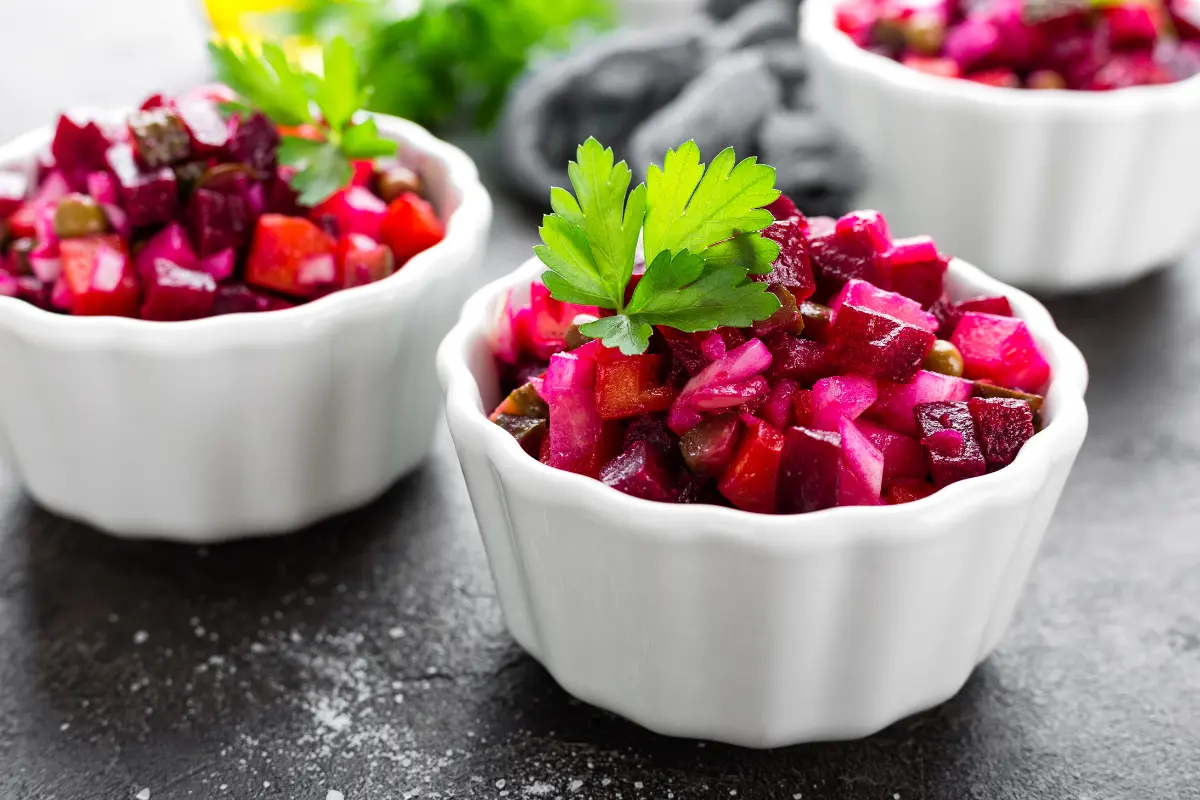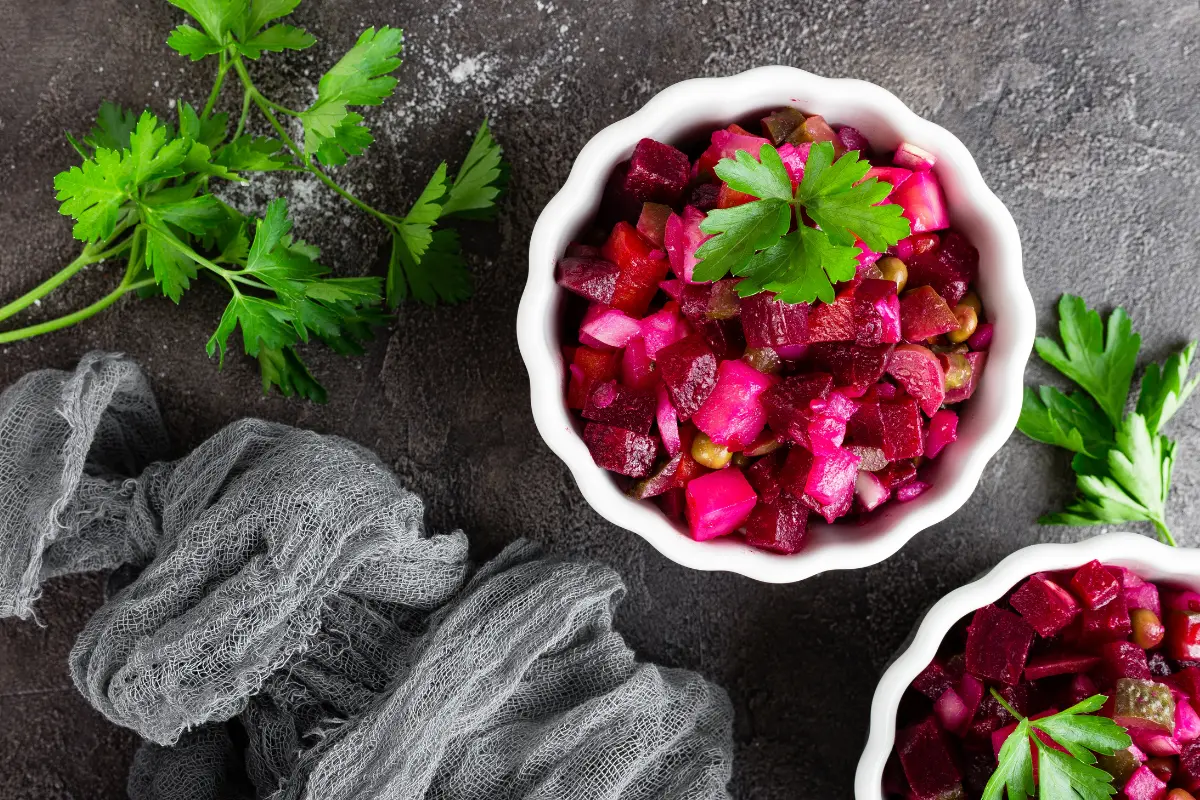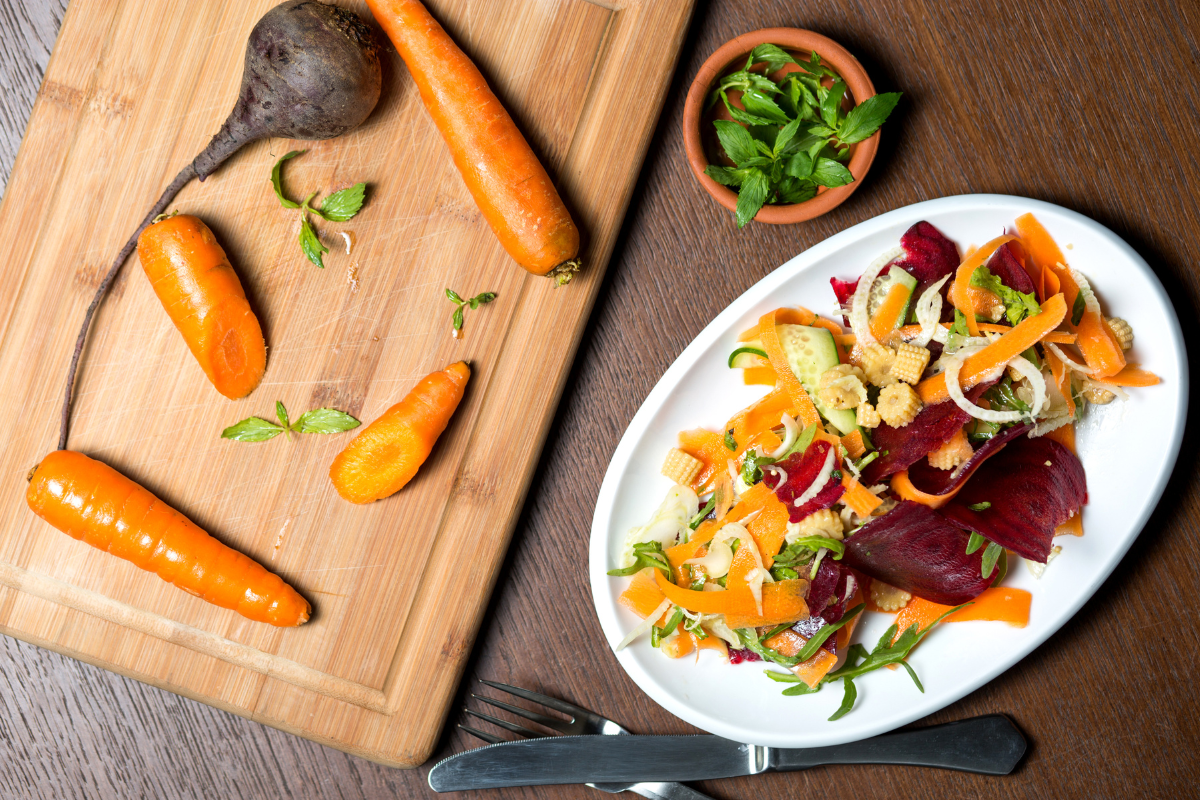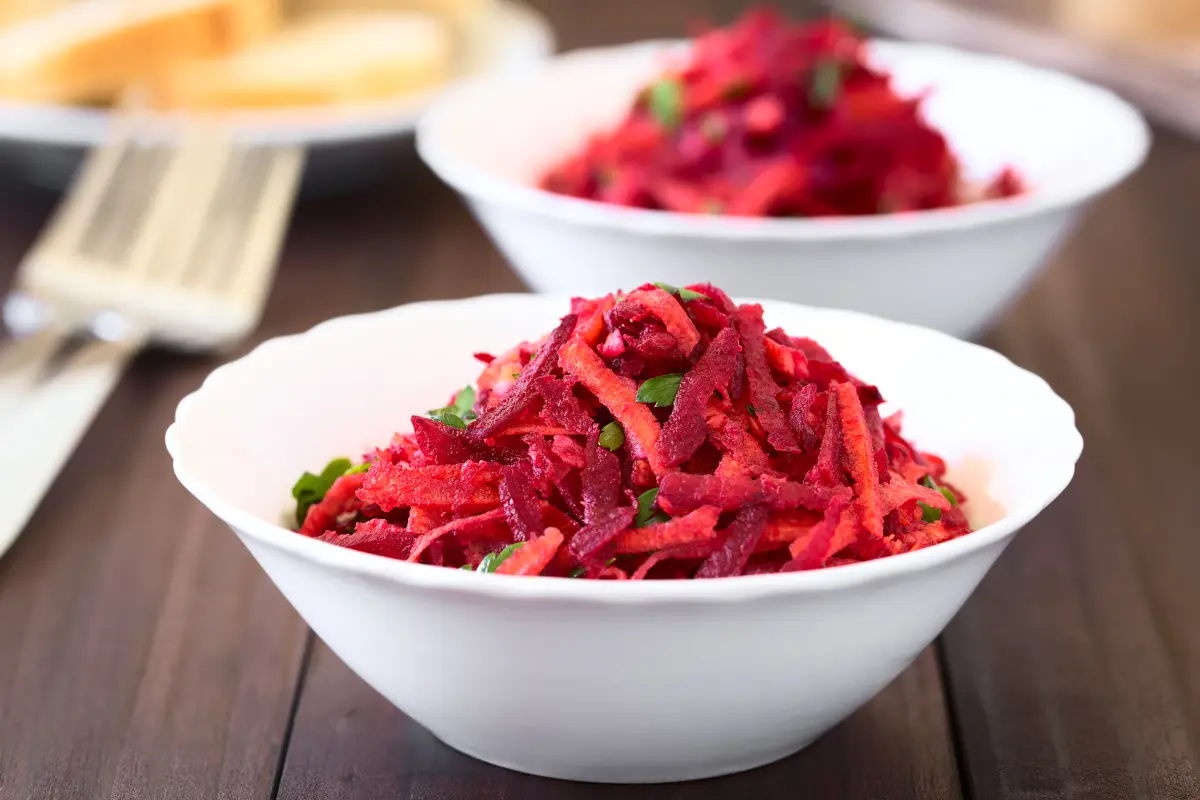Understanding Beetroot
Varieties and Nutritional Profile
Dive into the world of beetroots, and you’ll discover a rainbow of varieties, each with its unique taste and nutritional benefits. From the classic deep red beet to the striking golden beet and the candy-striped Chioggia, there’s more to these root vegetables than meets the eye. Each variety brings its own set of nutrients to the table, making beetroots a versatile choice for any health-conscious individual.
The nutritional profile of beetroots is as rich as its color palette. Packed with essential vitamins and minerals, beetroots are a boon for anyone looking to boost their health. They’re low in calories yet high in valuable nutrients, including folate, which is crucial for DNA synthesis and repair, making them an excellent choice for pregnant women. The fiber in beetroots aids digestion and helps prevent constipation, while the potassium content helps maintain a healthy blood pressure.
Health Benefits of Beetroot

The health benefits of beetroots are vast and varied. These vibrant root vegetables can improve athletic performance by enhancing blood flow and reducing the oxygen cost of low-intensity exercise while enhancing tolerance to high-intensity exercise. This is due to the nitrates found in beets, which the body converts into nitric oxide, a compound that relaxes and dilates blood vessels.
Beetroots are also known for their ability to help lower blood pressure, thanks to their high nitrate content. Studies have shown that beetroot juice can reduce systolic blood pressure by 4-5 mmHg over a period of only a few hours. Such an effect is attributed to the nitrates present in beets, which improve vascular function.
Moreover, the antioxidants in beetroots, particularly betalains, have been found to have anti-inflammatory properties and may protect against certain forms of cancer. The fiber in beetroots can also contribute to improved digestive health and aid in weight management by promoting feelings of fullness and reducing calorie intake.
Incorporating beetroots into your diet, whether raw or cooked, can thus offer a myriad of health benefits. Their versatility in the kitchen allows for endless culinary experiments, from salads and juices to roasted dishes and more. With such a wide array of nutritional benefits, it’s clear that beetroots are not just a colorful addition to your plate but a crucial component of a healthy, balanced diet.
health benefits like blood pressure improvement and antioxidant properties
Preparing Beetroot for Salad
Does beetroot need to be cooked for salad?
To Cook or Not to Cook
When it comes to preparing beetroot for salad, the debate between raw or cooked beets is a culinary crossroads many face. The truth is, both methods have their place in the kitchen, each bringing out different qualities of this versatile vegetable.
Raw Beetroot in Salads
Raw beetroot slices add a crisp, earthy texture and a vibrant pop of color to salads. When thinly sliced or grated, raw beets are surprisingly tender, making them a perfect match for leafy greens and a variety of dressings. For those who lean towards a more nutritious crunch, raw beetroot is your go-to. It retains all its vitamins and minerals, which can be diminished through the cooking process. Plus, it’s a time-saver, requiring no cooking at all!
To prepare raw beetroot for salad, start by peeling the outer skin with a vegetable peeler, then slice or grate it into your desired shape. A mandoline slicer is a handy tool for getting uniformly thin slices, ideal for a more delicate salad texture.
Cooking Methods for Beetroot
For those who prefer a softer texture or a sweeter taste, cooking beetroot is the way to go. Cooking can enhance the natural sweetness of beets, making them a delightful addition to any salad. Here are a few methods to consider:
- Boiling: Boil whole beets until they are fork-tender, usually about 30 minutes, depending on their size. Once cooled, the skins will slip off easily.
- Roasting: Roasting beetroots wrapped in foil or in a covered dish concentrates their flavors and sugars, giving them a richer taste. This method can take about 1 hour at 400°F (200°C).
- Steaming: Steaming beetroots preserve most of their nutrients and color. It’s a quicker method than boiling, taking about 30 minutes for medium-sized beets.
Each cooking method offers a unique texture and flavor profile to beetroots, making them versatile ingredients in salads. Whether you prefer the simplicity of raw beets or the comfort of cooked ones, there’s no wrong way to enjoy this nutritious vegetable in your salads.
So, as we slice, dice, boil, or roast, let’s remember that the preparation of beetroot for salads is an art as much as it is a science. The method you choose not only affects the taste and texture but also the nutritional content of your dish. With a little experimentation and a lot of love, beetroots can elevate your salads from mundane to magnificent. Now, armed with these tips and tricks, let’s dive into some beetroot salad recipes that will tantalize your taste buds and nourish your body.

Beetroot Salad Recipes
Beetroot, often simply called beets, is more than just a vegetable; it’s a powerhouse of nutrition and flavor, waiting to be unleashed in your kitchen. With its deep red hue and distinctive taste, beetroot has climbed the ranks to become a favorite among health enthusiasts and culinary experts alike. But what makes beetroot so special, and how can we best pair it with fruits to enhance its earthy flavor while reaping all its health benefits? …read more
Raw Beetroot Salad Ideas
Diving into the world of beetroot salads, let’s start with the raw, where the crispness and earthy flavor of beetroot shine brightly. A raw beetroot salad can be a refreshing and nutritious addition to any meal, offering a burst of color and a variety of textures.
One simple yet delightful recipe to try is a Raw Beetroot and Carrot Salad. Begin by grating equal parts of beetroot and carrot. Toss them in a dressing made from lemon juice, olive oil, salt, and a touch of honey for sweetness. Add some roasted walnuts for crunch and a sprinkle of feta cheese for a creamy contrast. This salad is not only a feast for the eyes but also a powerhouse of nutrients.
Another raw beetroot creation involves thinly slicing beetroots and apples for a crisp, refreshing salad base. Dress it with a vinaigrette made from apple cider vinegar, Dijon mustard, olive oil, salt, and pepper. Top with goat cheese and chopped parsley for an elegant, flavorful dish that’s as suitable for a weeknight dinner as it is for a special occasion.
Cooked Beetroot Salad Variations
For those who prefer the sweeter, softer profile of cooked beetroots, there are equally enticing salad options. Cooked beetroot lends itself well to warm salads, perfect for cooler months or when you crave something more substantial.
A classic Roasted Beetroot Salad involves cubing and roasting beetroots until tender, then mixing them with mixed salad greens, goat cheese, and pecans. A simple balsamic vinaigrette can tie all these elements together, creating a salad that’s both hearty and flavorful.
Another warm salad option is a Beetroot and Quinoa Salad. Begin by roasting or boiling your beetroots. Then, mix them with cooked quinoa, diced cucumber, and avocado for a variety of textures. A lemon-tahini dressing can add a creamy, tangy element that complements the earthiness of the beets beautifully.
These recipes showcase the versatility of beetroot in salads, whether raw or cooked. Each method brings out different flavors and textures, making beetroot a flexible ingredient that can adapt to your taste preferences and nutritional needs. So, whether you’re in the mood for something crisp and refreshing or warm and comforting, there’s a beetroot salad recipe waiting to be discovered and devoured.
As we explore these recipes, remember that the beauty of beetroot lies in its versatility. Beetroot salads offer more than just sustenance. They are a canvas for your culinary creativity, inviting you to follow these recipes or create your own. These salads are an experience. They celebrate flavors, textures, and colors, nourishing the body and delighting the senses. Next, we’ll address common questions and concerns about using beetroot in salads. This ensures you have all you need to fully enjoy this incredible vegetable.
Frequently Asked Questions
What tastes best with beets?
In the vibrant world of vegetables, beets carve out a special niche with their deep, earthy flavors and myriad health benefits. Yet, for all their nutritional prowess, beets often stir up a love-hate relationship on the palate. This article embarks on a culinary exploration, seeking out the perfect companions to tame the beet’s bold character and unlock new dimensions of flavor. From the tangy zest of citrus to the sweet whispers of summer berries, we’ll uncover how to make beets not just palatable but utterly irresistible. Along the way, we’ll sprinkle in nutritional insights, preparation tips, and creative recipes, ensuring that beets earn their rightful place in your kitchen repertoire. So, let’s dive into the beetroot saga, where vibrant colors meet bold flavors in a dance of culinary alchemy read more…
What does beetroot go well with?
In the vibrant world of vegetables, beetroot stands out not just for its vivid color but also for its profound health benefits. This article dives deep into the heart of beetroot’s versatility, particularly focusing on its culinary dance with fruits.
Let’s start this flavorful exploration, finding the perfect matches for beetroot and integrating them smoothly into your diet… read more
Can Beetroot Be Eaten Raw in Salads?
Absolutely! Eating raw beetroot is safe and nutritious. It adds a crisp texture and sweet, earthy flavor to salads. Raw beetroot keeps all its vitamins, minerals, and antioxidants. This makes it great for boosting health benefits. Just ensure it’s peeled and washed thoroughly before slicing or grating it into your salad.
How to Prepare Beetroot for Salad?
Preparing beetroot for salad can vary depending on whether you prefer it raw or cooked. For raw beetroot, simply peel the skin with a vegetable peeler and then slice, dice, or grate it as desired. If you’re opting for cooked beetroot, you can boil, steam, or roast it until tender. Remember, roasting can enhance the beet’s natural sweetness, while boiling and steaming preserve its nutrients and color. Once cooked, let it cool before adding it to your salad.
Best Dressings for Beetroot Salads
Beetroot salads are versatile and can be paired with a variety of dressings. For raw beetroot salads, a simple vinaigrette made with olive oil, lemon juice, or apple cider vinegar complements the beet’s earthiness well. A touch of honey or maple syrup can balance the acidity with sweetness. For cooked beetroot salads, consider richer dressings like a balsamic reduction or a creamy tahini dressing to enhance the beetroot’s natural sweetness. The key is to balance the flavors to complement the beetroot without overpowering it.

Conclusion
Adding beetroot to your salads is an excellent way to introduce color, texture, and numerous nutritional benefits to your dishes. Adding this adaptable vegetable to your dishes opens up limitless options. Enjoy the crunch of raw beetroot or the soft, sweet flavor when cooked. With the recipes and tips provided, you’re well-equipped to explore the myriad possibilities that beetroot offers.
Remember, the journey of incorporating beetroot into your salads is one of exploration and creativity. Each preparation method reveals unique flavors and textures. This variety lets you customize salads to your taste and nutritional needs. So, dive into experimenting with both raw and cooked beetroot. Explore different dressings and the vast possibilities of this vibrant vegetable. Beetroot does more than enhance your salad. It’s a nutritional powerhouse, transforming ordinary meals into something extraordinary

